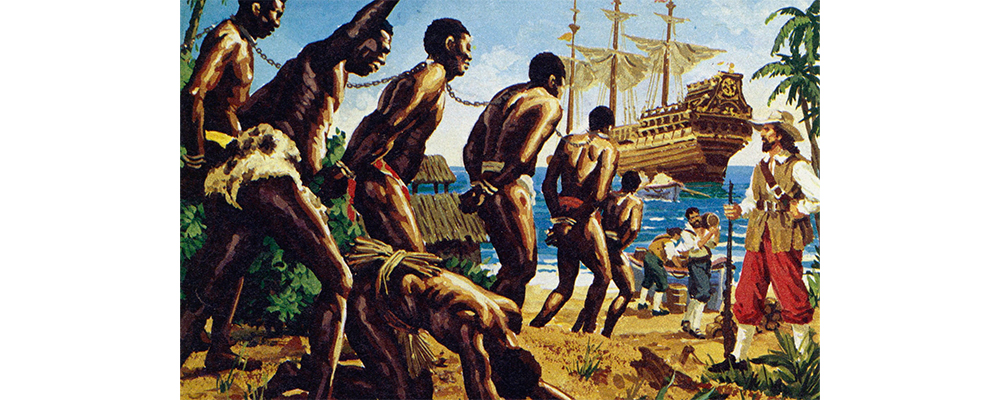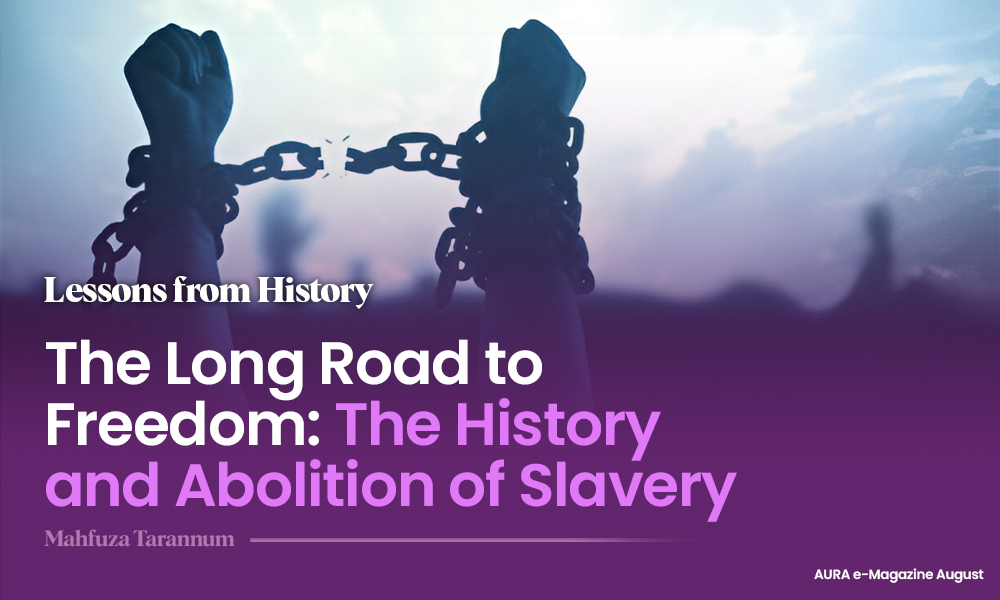Once, people were traded in the markets like cattle. They were sold as slaves. Although the slave trade began to disappear around the world in the last half of the nineteenth century, the history of slavery is very old. The movement and struggle to eradicate this inhuman practice have been going on for a long time. As a result of that movement and struggle, slavery gradually disappeared. To mark the end of this inhumane practice and to pay tribute to the heroes of the movement against the practice, the International Day for the Abolition of Slavery has been observed on August 23 every year since 1948, as per the decision of the United Nations.
A Catalyst for Human Rights and Equality
Issues such as equal rights and human rights are so much discussed in the world today, and important issues like the abolition of slavery have made the people of the world move forward in that way. The main objective of the International Day for the Abolition of Slavery is to raise awareness about the end of human trafficking, sex slavery, forced child labour, forced marriage and the use of children in war. History shows that in 1791, protests against slavery first started in present-day Haiti and the Dominican Republic. Later, Britain freed their African slaves in 1807 and the United States in 1808. The United Kingdom then outlawed slavery in 1833, France in 1848, and the United States in 1865. Yet still, around 1.2 million people around the world are held captive by forced labour, slavery and practices related to slavery.
Vast Structures Built on the Backs of Slaves
The ancient system of slavery is still spread under different names in different countries of the world. According to the history of human civilisation, slavery was first introduced in Mesopotamia between 4000 and 3000 BC. Thousands of years later, this practice spread to India through Egypt. Enslaved people built great structures like the Pyramids of Egypt. After this, the bad practice prevailed in China. Like the pyramids, the Great Wall of China was built with the sweat, blood and suffering of enslaved people. From 800 to 700 BC in Greece and 200 BC in Rome, slavery began to spread rapidly. In this way, the terrible practice spread almost all over the world.
The Infamous Trans-Atlantic Slave Trade
The slave trade was prevalent around the world. The worst form of slave trade was seen in the ‘Trans-Atlantic Slave Trade’ in the Middle Ages. October 12, 1492, can be said to be a day that changed the history of humanity. On that day, the sailor Columbus and his companions set foot on the soil of the American continent, thinking that they had reached the soil of India. From then on, Europeans started flocking like locusts to this newly discovered continent. The local tribals were slowly removed, and they started occupying their land. Europe lacked a large area of arable land. Therefore, they got a large area of vacant arable land, as if they had the moon in the market. Extensive farming began, but oppression of the natives increased. However, the problem was that they did not have the workforce to cultivate the thousands of miles of uncultivated land on two huge continents, North America and South America. To solve that problem, millions of black people were brought from Africa to work on agricultural land. As enslaved people were brought from Africa across the Atlantic Ocean to America, it is known in history as the ‘Trans-Atlantic Slave Trade’.
The most despicable and horrible form of the slave trade was seen in the ‘Trans-Atlantic Slave Trade.’
The first slave ship from Europe arrived in America in 1502. It was a Spanish ship. Initially, the slave trade was entirely in the hands of the Portuguese and the Spanish. Over time, England, the Netherlands and France became equally involved in this business. The slave trade, which began in the early sixteenth century, continued for about three and a half hundred years until the mid-nineteenth century. About one and a half million to two million African women, men and children were captured as enslaved people during this time. About one-third of them died while being brought by sea, either from torture or from starvation and disease. About 8 million enslaved people were brought to Brazil alone andorty lakhs to the United States. The rest were sent to Haiti and other Caribbean islands.
The main centre of the slave trade was the coastal region of West Africa, which stretched from Senegal to Angola. The most important points of the slave trade were Benin, Togo and the west coast of Nigeria. Hence, the area was called the Slave Coast. European slave traders bought prisoners of war, criminals, debtors and rebels as enslaved people from local Africans. Besides, many ordinary people were also kidnapped by slave traders and sold as slaves. Enslaved people were brought from a total of 45 ethnic groups. Most of them were indigenous or followers of local African cultures.
Enslaved people were taken by force. So, it was very natural for the slave traders to use various tortures to compel them. A large number of people died on it while crossing the Atlantic. To save costs, ships used to carry people in piles. There was no sanitation and adequate food. But the worst situation was after being brought to America. About a third of the enslaved people died of diarrhoea and dysentery in the seasoning camps there. Many died while fleeing to escape the humiliation, and some committed suicide. Enslaved people were considered the property of the master. Although slavery has existed in many parts of the world since the distant past, nowhere has its inhumanity surpassed that of American slavery. To the American landowners, enslaved people were mere implements of agricultural labour.
Until the Industrial Revolution, the economies of the European colonies were slave-labour dependent. Cotton in North America and sugar in Brazil and the Caribbean were the main cash crops of the great powers of Europe. The sugar of the Caribbean was then brought throughout Europe to drink tea from India. There was fierce competition between France and England to control the global sugar market. It has been said that the Industrial Revolution of England started from the American corpus cotton. And the blue of the white cloth made from that cotton was supplied from our country. That is another history of cruelty. However, the economic appeal of the slave trade began to decline after the Industrial Revolution. Therefore, from the 19th century, there were demands to abolish the slave system.

Abraham Lincoln’s Role in Abolishing Slavery in the United States
England was the first to abolish slavery in 1807 officially. Then, one by one, the slave trade was declared abolished in other European countries. Brazil was the last country to outlaw the slave trade in 1830. However, it took until the 1860s for the illegal slave trade to stop. The American Civil War and slavery are deeply intertwined. In 1861, shortly after Republican President Abraham Lincoln took office, the American Civil War broke out. Initially, the Civil War was the culmination of years of conflict between the American North and South over slavery. Lincoln’s challenge was settling the war as quickly as possible, but the main problem was that he could not abolish slavery if he wanted to.
Centuries-old slavery was enshrined in the U.S. Constitution, and no president before Lincoln had taken steps to amend the Constitution. On the other hand, since each American state had the freedom to make its laws, slavery gradually disappeared from each northern state. However, radical white supremacy was so prevalent among hardline Southerners that they played no part in the abolition of slavery, which played a major role in causing the Civil War.
Lincoln’s priority early in the Civil War was to suppress the rebellion. This is evident in the various steps taken by him. On August 6, 1861, he passed a law known as the ‘Confiscation Act’. It ordered the confiscation of property of those who supported the rebellion in the south. Since enslaved people were also considered property, this law freed more than ten thousand enslaved people within a year. However, the law did not explain whether these slaves were freed from their masters and were free at all and could later become slaves of another master. So, this law could not play an effective role. But, it was able to garner the political support needed to abolish slavery.
As the war progressed, Abraham Lincoln’s influence increased. At first, he only wanted to unite America, but when the opportunity came to fulfil his long-held desire by freeing the slaves, he seized it. This political vision helped to make him one of American history’s most successful and popular presidents. Thus, slavery was permanently banished from the United States in 1865.
Slavery in the Indian Subcontinent
Slavery was very prevalent in Bengal as well as in the subcontinent. As of 1862, there were 27,000 enslaved people in Assam and 125,000 in Chittagong. The average price was twenty rupees. Most of the enslaved people in this region were its inhabitants. Some foreign slaves also came. About 100 foreign slaves used to go to Calcutta every year. According to the news published in a newspaper in 1830, the Nawab of Ayodhya bought five beautiful foreign girls and seven foreign men at a high price. The price was twenty thousand rupees. There are also precedents for announcing rewards for surrendering fugitive slaves. British Warren Hastings ruled that an enslaved person must be registered in court when buying. This fee was 4 taka or four annas per enslaved person in Calcutta. Most of the slaves in the region were either the ones who sold themselves due to famine or were low-class people or children caught by slavers. The Sultans of Bengal, however, bought slaves from Africa, Turkestan, Persia and China. In the late 1830s, the highest prices were for ‘Negro’ and ‘Kafri’ slaves brought from Africa. In Hindu society, slaves bought with money were called ‘Kritdas’ or ‘Das’ and female slaves were called ‘Dasi’. In Muslim culture, male slaves were called ‘Golam’ or ‘Nafar’ and female slaves were known as ‘Bandi’.
Moreover, the price and demand for beautiful bandis were also high. Unable to repay moneylenders, many people sold themselves as slaves. In Sylhet, Mymensingh, Chittagong and Dhaka regions, according to the report of the Law Commission of 1839, one-fifth of the people were slaves. By the end of the 18th century, slavery had ended. Act Five of 1843 paved the way for the abolition of slavery in the region.
The Persistence of Modern Slavery
‘Slavery’ refers to forcing a person to perform forced labour and, in this case, treating a person as the ‘moveable property’ of another person. The place or ownership changes against the will of the people bound in this chain of slavery. There is no wage for their labour. In some societies in the past, it was legal to kill one’s slave. Mankind has come out of those barbarities. However, the modern transformation of slavery requires finding a way to get rid of it. Human civilisation is moving forward. Third-world countries like Bangladesh are not lagging in that progress. In this context, it is hoped that any form of slavery will not tarnish the progress of the nation.


0 Comments